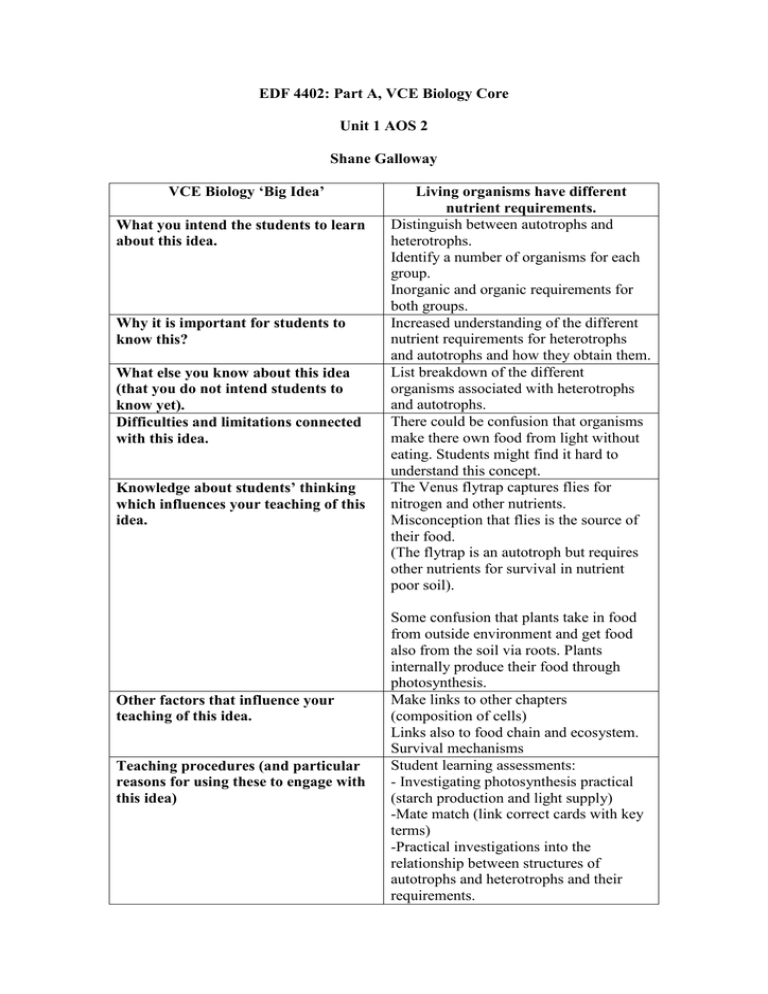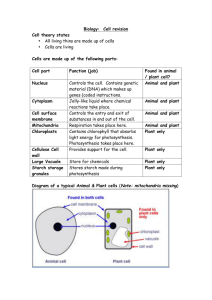EDF 4402: Pt A, VCE Biology Core
advertisement

EDF 4402: Part A, VCE Biology Core Unit 1 AOS 2 Shane Galloway VCE Biology ‘Big Idea’ What you intend the students to learn about this idea. Why it is important for students to know this? What else you know about this idea (that you do not intend students to know yet). Difficulties and limitations connected with this idea. Knowledge about students’ thinking which influences your teaching of this idea. Other factors that influence your teaching of this idea. Teaching procedures (and particular reasons for using these to engage with this idea) Living organisms have different nutrient requirements. Distinguish between autotrophs and heterotrophs. Identify a number of organisms for each group. Inorganic and organic requirements for both groups. Increased understanding of the different nutrient requirements for heterotrophs and autotrophs and how they obtain them. List breakdown of the different organisms associated with heterotrophs and autotrophs. There could be confusion that organisms make there own food from light without eating. Students might find it hard to understand this concept. The Venus flytrap captures flies for nitrogen and other nutrients. Misconception that flies is the source of their food. (The flytrap is an autotroph but requires other nutrients for survival in nutrient poor soil). Some confusion that plants take in food from outside environment and get food also from the soil via roots. Plants internally produce their food through photosynthesis. Make links to other chapters (composition of cells) Links also to food chain and ecosystem. Survival mechanisms Student learning assessments: - Investigating photosynthesis practical (starch production and light supply) -Mate match (link correct cards with key terms) -Practical investigations into the relationship between structures of autotrophs and heterotrophs and their requirements. Specific ways of ascertaining students’ understanding or confusion around this idea (include likely range of responses) Incorporate concept maps with photosynthesis and also heterotrophs and autotrophs. Students explain key terms with Mate Match pairing. Students describe and explain what is happening in the photosynthesis practical. How the rate of photosynthesis is affected? The teacher deliberately makes mistakes and waits for students to notice. (Wrong organism for specific groups, photosynthesis reaction written incorrectly, wrong reactants and products). VCE Biology Unit 1 AOS 2: Functioning organisms Key idea 1 – Living organisms have different nutritional requirements Outline of key idea 1: Distinguish between autotrophs and heterotrophs and identify a number of organisms for each group. Identify inorganic and organic requirements for both groups as well as the structural features that help them utilise these nutritional requirements. Learning activities Learning activity 1: a) Identifying the effect of light in photosynthesis and b) Testing leaves for starch - technique In this activity, students discuss and witness how the contribution of light energy creates starch through photosynthesis. Through this activity they gain an understanding of how starch is produced with and without the presence of light on leaves. Students also gain experience in using a cell staining technique to indicate the presence of starch (excess glucose) in leaf cells. An understanding of cell structures in leaves is highlighted and the extraction of chlorophyll is achieved through the leaf technique. VCAA VCE Biology Links: Content: Revision of unit 1: Area of study 1 - biochemical processes including photosynthesis; cell structure; external and internal environments of cells (VCAA VCE Biology Study Design page 14) Unit 2: Area of Study 1 – organic and inorganic requirements; autotrophs; inputs and outputs of photosynthesis (VCAA VCE Biology Study Design page 15) Key Skills: Investigate and inquire scientifically Collect, process and record information systematically; analyse and synthesis data; draw conclusions consistent with the question under investigation and the evidence obtained Act responsibly when conducting investigations; maintain safe practices; work independently and collaboratively as appropriate Apply biological understandings Apply understandings to familiar and new contexts; make connections between concepts Resources Student worksheet: Teacher notes: Adapted from: Biology 1, Heinemann 4th edition. Workbook booklet: worksheet number 12, Starch stations – investigating photosynthesis (pg………) http://www.practicalbiology.org/areas/introductory/energy/photosynthesis/ide ntifying-the-conditions-needed-for-photosynthesis,74,EXP.html http://www.practicalbiology.org/areas/introductory/energy/photosynthesis/test ing-leaves-for-starch-the-technique,73,EXP.html Learning activity 2: Chemical digestion of Starch In this activity, students learn how nutrients can be broken down into smaller molecules through a process of chemical and mechanical digestion. This activity provides an understanding of how food can be utilised by the human body through the action of digestive enzymes. Also the practical highlights how nutrients can be absorbed into the human body as well. They are encouraged to develop an understanding of the processes involved and this translates in the human body. VCAA VCE Biology Links: Content: Revision of unit 1: Area of study 1 – general role of enzymes in biochemical activities of cells (VCAA VCE Biology Study Design pg 14) Unit 2: Area of Study 1 – organic and inorganic requirements; heterotrophs (VCAA VCE Biology Study Design pg 15) Key Skills: Investigate and inquire scientifically Collect, process and record information systematically; analyse and synthesis data; draw conclusions consistent with the question under investigation and the evidence obtained Act responsibly when conducting investigations; maintain safe practices; work independently and collaboratively as appropriate Apply biological understandings Apply understandings to familiar and new contexts; make connections between concepts Resources Student worksheet: Teacher notes: Adapted from: Haileybury College, Keysborough. Biology Department. Unit 1 Area of study 1, ‘Chemical Digestion of Starch Laboratory Practical”. 2011, 1-2. Learning activity 3: Leaf structure and function In this activity, students learn about the structures found in leaves and how they vary between different environmental conditions. This activity also provides an understanding into the structure and function of stomata located on the leaf surface and what role they play in photosynthesis. VCAA VCE Biology Links: Content: Revision of unit 1: Area of study 1 – biochemical processes including photosynthesis (VCAA VCE Biology Study Design page 14) Unit 2: Area of Study 1 – organic and inorganic requirements; autotrophs, inputs and outputs of photosynthesis and structural features of photosynthetic organisms (VCAA VCE Biology Study Design page 15) Key Skills: Investigate and inquire scientifically Collect, process and record information systematically; analyse and synthesis data; draw conclusions consistent with the question under investigation and the evidence obtained Act responsibly when conducting investigations; maintain safe practices; work independently and collaboratively as appropriate Apply biological understandings Apply understandings to familiar and new contexts; make connections between concepts Resources Student worksheet: Teacher notes: Adapted from: Haileybury College, Keysborough. Biology Department. Unit 1 Area of study 1, ‘Stomata Structure and Function’, SAC 3. 2011, 1-2. Other Resources: Videos: Gums to Bums – Demonstration on the process of digestion from your mouth all the way to the toilet. Very good demo to use in class, McDonalds food is great to demonstrate with. http://www.youtube.com/watch?v=UJRHo6eA7DY Photosynthesis – Basic and informative video on the process of photosynthesis and the structures involved. http://www.youtube.com/watch?v=bS5WZ5fIk-c The Heterotrophic Blues – A song about heterotrophs and autotrophs with Elvis Parsley http://www.youtube.com/watch?v=UNqvM25Plxk&feature=related Websites: Awesome Science Teacher Resources Biology website that has a number of resources for photosynthesis. Activities, games, worksheets, songs, links and useful pictures and diagrams. http://www.nclark.net/PhotoRespiration On-line Biology Book Photosynthesis chapter that has review questions and detailed pictures. http://www2.estrellamountain.edu/faculty/farabee/biobk/biobooktoc.html Podcasts: Douchy’s Biology Podcast – 2008, Cellular Respiration and Photosynthesis VCE Biology Podcast – Mr Barlow, Episode 3 and 6, Autotrophs and Photosynthesis Mr Barlow, Episode 7, Digestion and Digestive Systems Other Activities: Biozone Student Workbook 2011 Year 11 Biology, Great resource for students, detailed worksheets, encourages higher order thinking. Teacher resources available. Plant and Animal Nutrition - Plants as producers - Photosynthesis - Leaf structure - Adaptations for photosynthesis - Mammalian dentition - The human digestive tract - Methods of feeding



